Nationwide pulled a “Debby Downer” during last night’s Superbowl, and the ad went over like an ISIS beheading at a Circus. Here’s the commercial, titled “Boy.”
Here are a few of my favorite memes. Yours?
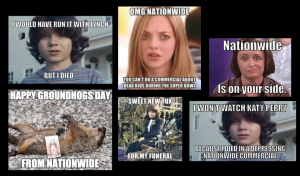
Nationwide pulled a “Debby Downer” during last night’s Superbowl, and the ad went over like an ISIS beheading at a Circus. Here’s the commercial, titled “Boy.”
Here are a few of my favorite memes. Yours?

Mother’s everywhere are mourning the loss of their young boys as they become a man. And in this Old Spice “Mom Song” commercial, they’re singing as they stalking their children, clutching to their cars while riding laundry bins, and showing up in odd places like beaches and cafeteria
A superbowl commercial website is calling this ad creepy, but it’s absolutely my favorite Old Spice ad since Mustafa’s “this is what your man could smell like” viral hits of 2009 and 2010. I hope the agency (still Wieden and Kennedy) runs it on the 2014 Superbowl. There’s a also a shorter alternative with a woman popping her head from a bowling ball machine.
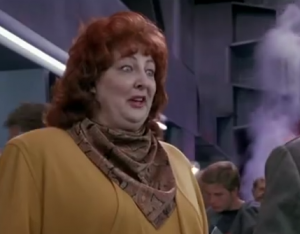
My day job, when not a Viral Video Genius, is insights strategy at an advertising agency (which works in healthcare and has nothing to do with this spot). I’ve worked with P&G but not in many years.
So I like to try to imagine what “insights” drove this campaign. Here’s my guess:
So the creative challenge was likely to win over moms by satirizing the clingy mom who won’t let their kids grow up. “You, dear shopper, do not look like Arnold in drag in Total Recall.”
Note what the spot doesn’t do: it’s not telling moms to “let go,” or “buy Old Spice to help them get the girls,” which would have the opposite of the desired effect. This just in: seems I called it right according to this AdAge piece that attributes the song to musical agency “Walker.”
What ya think? Love it like me? Freaked by it? Think it will work?

Finally an interactive, immersive online video ad that doesn’t skimp on the comedy or selling. Patrick Warburton takes us on ‘GOOD REASONS,” an interactive entertainment experience that highlights Honda and takes the viewer on a guided web surf. While the interactivity is limited during the 9 modules, Warburton’s script is clever… he’s seen tapping a Tweet or Facebook like page, and he’s best when left alone between module selections. I discovered the ad on YouTube, and probably spent 15 minutes with it.
Warburton generally walks that fine line between being confidently funny and glib, and it’s hard not to think of his voiceovers during the experience…. especially Kronk.

The work was created, at least in part, by Justin Young, who left Firstborn Multimedia in NYC and leads “This Is His” an LA-based interactive design and post production shop. Check out the behind-the-scene stills… and read more about the shoot here.
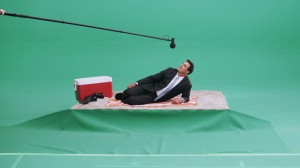 Or my version of the photo (and I could have done this without the green screen, Honda.
Or my version of the photo (and I could have done this without the green screen, Honda.
Yes. Video prerolls are both growing and declining. The good news for viewers is that we saw fewer prerolls. But we saw more “polite prerolls” (option to escape) in Q1 2011 as reported by AdoTube/eMarketer. Since this doesn’t include YouTube data and presumably a small sample of total online-video ad streams it does need to be taken with a grain of (Morton’s: when it rains it pours!) salt.
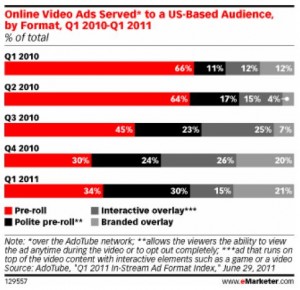
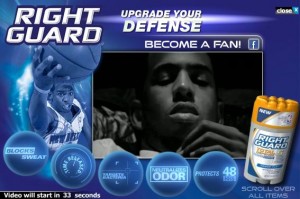
Forget prerolls, friends. The increasingly competitive ad networks have a whole sleuth of weapons in their online-video ad formats that range from the innocuous “polite pre-roll,” to a bit more ominous names like in-stream takeover, ad selector, in-stream skin, inside-out roll, interactive overlay, video-in-video, interactive gaming overlay, data entry and capture, branded player, over the top, and beyond stream. I believe that Seroquel example, placing a “reminder” ad without “fair balance” adjacent to depression content is (shhh) a violation of FDA guidelines, but I digress. ANY of these ad-format names beats the “fat boy” branded by Point Roll.
Take a look at some of the bold “engagement” formats presented in AdoTube’s ad-format gallery and you’ll see why viewers are, according to eMarketer, about 30% likely to engage in an ad… even when not forced (hence the term “polite”). You’ll also see that it’s often not clear there’s an opt-out available.
The eMarketer report, titled “Options for Online Video Ad Viewers Leads to Higher Engagement” is encouraging. With online video being one of the leading (if not #1) fastest-growing portion of a marketer’s “media mix,” advertisers will want and expect formats that achieve their goals: from branding to engagement. This chart is important to viewers because it shows that “cost per impression” remains the dominant percent of spending. In “cost per impression” (often called CPM, or cost-per-thousand), the advertiser simply pays a few bucks to reach 1,000 eyeballs without much accountability.
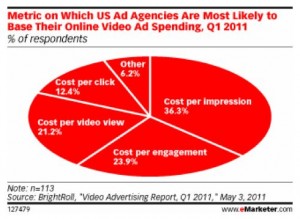
While few of us welcome more aggressive online-ads, this also substantiates a business model to fuel the medium’s growth. While it’s easy to complain about intrusive ads (especially as the pendulum seemed to swing dangerously to the advertiser’s benefit in the past year), it’s a vital element to online-video’s maturity. If the advertisers don’t get what they need, friends, we won’t be seeing our content for free.
There are three ways to increase “engagements” in this online-video advertising medium, and I’ll list them from best to worst in order of sustainability: novelty, creative and targeting:
So what are the takeaways to advertisers, video sites and us viewers?
Well it seems things are fine in TV Land. A recent study shows that TV ads beat the web in creating engagement (specifically by 38 gagillian times).
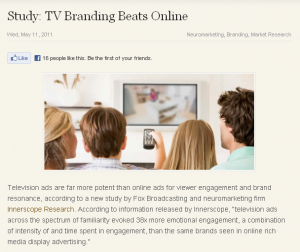
And a previous study shows we don’t miss the ads we skip. Good news, media buyers! Get those bucks back on television.
Next week: Print is alive!
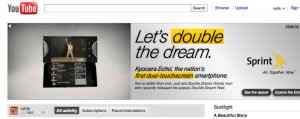
Who’s that guy in the green shirt dancing in Sprint ads? Well you heard about “double dream hands” guy here first, right? (Heck I even own one of his yellow shirts).
Now he’s back with “double dream feet,” which appearance in a Sprint television ad (and, above, as repurposed on YouTube). He’s John Jacobson, and his new YouTube channel is here.

The White House Correspondents’ Association dinner is a historic break from the tension between the White House and the media covering it. This year President Barack Obama joked about a sequel to the film the King’s Speech. Here’s the video that was shared, and it’s a clever self-deprecating parody of the film, and shows rare out takes of the president’s recorded addresses.
When I worked at Georgetown, President Clinton (an alumnus) sent some video footage to us for an event, and there were a number of outtakes they included. I wonder what I might have done with those had YouTube existed in the early 1990s.
Thanks Jan for sending over this article titles, “Do You Know Why Nobody Is Clicking Your Ads.”
http://www.mequoda.com/articles/web-advertising/do-you-know-why-users-arent-clicking-on-your-ads
It’s true that ad units generally decrease on interaction rates as people get used to them. The article cites a .09 percent click thru rate, but I’d say that’s being quite generous. It’s also worth noting that some ads are measured not by clicks but by recall rates (and how they improve as measured by surveys).
The piece does have some nice pointers about making ads look less junky (and, duh, relevant). The more flashy and obnoxious, the more they’re ignored. As Brad Aronson (author of Internet Advertising, Wiley) told me… The best color for an ad is the same color as the website. When an ad looks like editorial it gets more attention.
In my experience reviewing eye-tracker studies there are lots of learnings… And the vast majority of ads are “impressions” that make no impression– they literally are never seen by an eye.
The nice thing about video ads (especially mandatory preroll) is while they’re somewhat intrusive… The recall rates are generally far better.
I gotta go poop now. Bye.
Imagine sending a fax from the beach via a computer, or using a payphone to say goodnight to your child… from another timezone.

It was all part of AT&T’s WE WILL campaign, and remarkably accurate in its general predictions. But unfortunately we’re not sure the telecommunications company pulled any of these off. Hey- at least they were thinking.

comScore’s February data once again shows Google’s dominance in the online-video market, but Facebook is catching up. It’s now the fourth-largest online-video sharing property (see Facebook’s unofficial resource for more information). Facebook, as a sharp contrast from other sites, has short bursts of viewing (far shorter durations than other properties like YouTube, Hulu or Viacom (see BroadbandTV report).
comScore has a nice presentation that shows the “radical” growth of the medium (see download), and the total people relative to streams. It seems that the longer format of professional content (basically TV shows streamed online) is attracting a greater portion of advertising today.
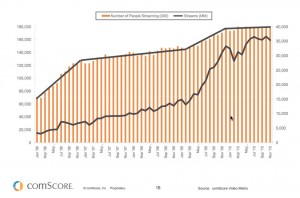
To me, the most interesting part of this report is the acknowledgement that advertising dollars aren’t keeping up with the increase in online-video viewing. While this is probably true for the dawn of every preceding medium (radio, television, internet), it does suggest media buyers are in need of additional adjustments of the “media mix.” This requires better planning, and more creative built for the channel.
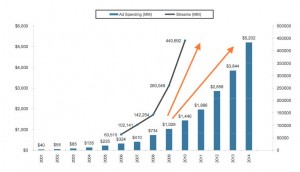
Because media-buying agencies (representing top brands) are more comfortable with television, it’s no surprise that Hulu is serving more ads per minute streamed. It’s familiar content and an easier format. Of course advertisers should be looking not just for “comfort” and targeting, but also “reduced clutter.”
Note that YouTube is not leader in advertising delivery (when you look at “ad views”). After Hulu, Tremor Media Video Network ranked second overall (and highest among video ad networks) with 503.7 million ad views, followed by ADAP.TV (432 million) and Microsoft sites (415 million).